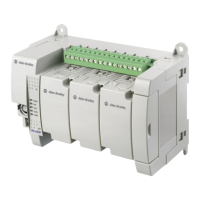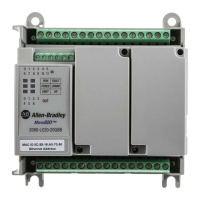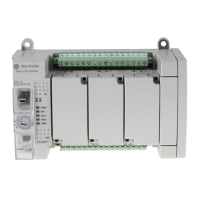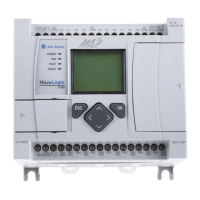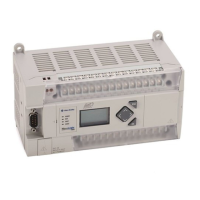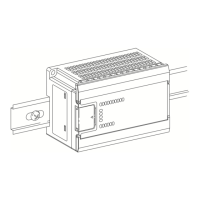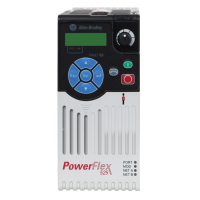64 Rockwell Automation Publication 2080-UM002G-EN-E - March 2015
Chapter 6 Program Execution in Micro800
Variable Retention
Micro830 and Micro850 controllers retain all user-created variables after a power
cycle, but the variables inside instances of instructions are cleared. For example: A
user created variable called My_Timer of Time data type will be retained after a
power cycle but the elapsed time (ET) within a user created timer TON
instruction will be cleared.
Unlike Micro830/Micro850 controllers, Micro810 and Micro820 controllers
can only retain a maximum of 400 bytes of user-created variable values. This
means that after a power cycle, global variables are cleared or set to initial value,
and only 400 bytes of user-created variable values are retained. Retained variables
can be checked at the global variable page.
Memory Allocation
Depending on base size, available memory on Micro800 controllers are shown in
the table below.
These specifications for instruction and data size are typical numbers. When a
project is created for Micro800, memory is dynamically allocated as either
program or data memory at build time. This means that program size can exceed
the published specifications if data size is sacrificed and vice versa. This flexibility
allows maximum usage of execution memory. In addition to the user defined
variables, data memory also includes any constants and temporary variables
generated by the compiler at build time.
The Micro800 controllers also have project memory, which stores a copy of the
entire downloaded project (including comments), as well as configuration
memory for storing plug-in setup information, and so on.
Guidelines and Limitations
for Advanced Users
Here are some guidelines and limitations to consider when programming a
Micro800 controller using Connected Components Workbench software:
• Each program/POU can use up to 64 Kb of internal address space. It is
recommended that you split large programs into smaller programs to
improve code readability, simplify debugging and maintenance tasks.
• A User Defined Function Block (UDFB) can be executed within another
UDFB, with a limit of five nested UDFBs. Avoid creating UDFBs with
references to other UDFBs, as executing these UDFBs too many times may
result in a compile error.
Memory Allocation for Micro800 Controllers
Attribute 10/16-point 20-point 24- and 48-points
Program steps
(1)
(1) Estimated Program and Data size are “typical” – program steps and variables are created dynamically.
1 Program Step = 12 data bytes.
4 K 10 K 10 K
Data bytes 8 KB 20 KB 20 KB

